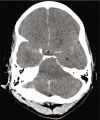Pseudosubarachnoid hemorrhage: A systematic review of causes, diagnostic modalities, and outcomes in patients who present with pseudosubarachnoid hemorrhage
- PMID: 33598345
- PMCID: PMC7881521
- DOI: 10.25259/SNI_905_2020
Pseudosubarachnoid hemorrhage: A systematic review of causes, diagnostic modalities, and outcomes in patients who present with pseudosubarachnoid hemorrhage
Abstract
Background: Patients with computed tomography (CT) findings consistent with subarachnoid hemorrhage without evidence of hemorrhage following autopsy or cerebrospinal fluid testing are termed to have pseudosubarachnoid hemorrhage (pSAH).
Methods: A systematic review of literature was conducted based on the preferred reporting items for systematic reviews and meta-analysis statement. Studies were evaluated for associated cause of pSAH, imaging modality used in assessment, method of confirmatory testing, and clinical outcome.
Results: Fifty studies were included in qualitative analysis including 197 cases of pSAH. Systematic review revealed 23 studies including 110 patients with pSAH attributed to hypoxic-ischemic brain injury following cardiac arrest. Three studies were included in meta-analysis that quantitatively analyzed differences in CT densities in patients with pSAH and true subarachnoid hemorrhage (true SAH). A random effects model meta-analysis showed a statistically significant decrease in densities in the Sylvian fissure in patients with pSAH compared to true SAH and a statistically significant decrease in densities in adjacent parenchyma in patients with pSAH compared to true SAH. Systematic review further revealed 32 patients with pSAH associated with spontaneous intracranial hypotension, 11 patients with pSAH related to infectious etiologies, 15 patients with pSAH associated with subdural hemorrhage, 20 cases of pSAH related to hyperhemoglobinemia, 2 cases related to valproate toxicity, and individual cases related to hyponatremia, diabetic ketoacidosis, sudden infant death syndrome, cerebellar infarction, and dialysis disequilibrium syndrome.
Conclusion: This study is the first systematic review of causes, diagnostic modalities, and outcomes in patients who present with pSAH. A diagnosis of pSAH may be considered following assessment of CT densities following cardiac arrest.
Keywords: Cardiac arrest; False subarachnoid hemorrhage; Pseudosubarachnoid hemorrhage; Systematic review.
Copyright: © 2020 Surgical Neurology International.
Conflict of interest statement
There are no conflicts of interest.
Figures





Similar articles
-
Successful treatment with hyperbaric oxygen therapy for severe brain edema characterized by radiological appearance of pseudosubarachnoid hemorrhage in a child.Exp Ther Med. 2016 Sep;12(3):1625-1627. doi: 10.3892/etm.2016.3463. Epub 2016 Jun 17. Exp Ther Med. 2016. PMID: 27588084 Free PMC article.
-
Quadrigeminal perimesencephalic subarachnoid hemorrhage.Clin Neurol Neurosurg. 2015 Oct;137:67-71. doi: 10.1016/j.clineuro.2015.06.018. Epub 2015 Jun 27. Clin Neurol Neurosurg. 2015. PMID: 26151343
-
Should Patients Be Counseled About Possible Recurrence of Perimesencephalic Subarachnoid Hemorrhage?World Neurosurg. 2016 Oct;94:580.e17-580.e22. doi: 10.1016/j.wneu.2016.07.112. Epub 2016 Aug 10. World Neurosurg. 2016. PMID: 27521726 Review.
-
Positive Predictive Value of Primary Subarachnoid Hemorrhage Diagnoses on Death Certificates.Clin Invest Med. 2022 Sep 21;45(3):E9-13. doi: 10.25011/cim.v45i3.38874. Clin Invest Med. 2022. PMID: 36149053
-
Determining the Diagnostic Utility of Lumbar Punctures in Computed Tomography Negative Suspected Subarachnoid Hemorrhage: A Systematic Review and Meta-analysis.World Neurosurg. 2021 Apr;148:e27-e34. doi: 10.1016/j.wneu.2020.11.152. Epub 2020 Dec 4. World Neurosurg. 2021. PMID: 33285333
Cited by
-
Cerebral edema associated with diabetic ketoacidosis: Two case reports.Acute Med Surg. 2023 Jun 20;10(1):e860. doi: 10.1002/ams2.860. eCollection 2023 Jan-Dec. Acute Med Surg. 2023. PMID: 37346084 Free PMC article.
-
[A case of sepsis complicated by multiple organ dysfunction syndrome with CT appearance of pseudo-subarachnoid hem-orrhage].Zhejiang Da Xue Xue Bao Yi Xue Ban. 2025 Jan 25;54(1):115-119. doi: 10.3724/zdxbyxb-2024-0022. Zhejiang Da Xue Xue Bao Yi Xue Ban. 2025. PMID: 39909464 Free PMC article. Chinese.
-
Pseudo Subarachnoid Hemorrhage Sign in Bacterial Meningitis in a Patient Presenting With Acute Ischemic Stroke: A Novel Radiological Clue to Rapid Diagnosis.Cureus. 2022 May 24;14(5):e25283. doi: 10.7759/cureus.25283. eCollection 2022 May. Cureus. 2022. PMID: 35755497 Free PMC article.
References
-
- Ahn JH, Choi SC, Jung YS, Min YG. Clinical characteristics of patients with pseudo-subarachnoid haemorrhage who were successfully resuscitated from out-of-hospital cardiopulmonary arrest. Hong Kong J Emerg Med. 2012;19:85–91.
-
- Al-Yamany M, Deck J, Bernstein M. Pseudo-subarachnoid hemorrhage: A rare neuroimaging pitfall. Can J Neurol Sci. 1999;26:57–9. - PubMed
-
- Arlt S, Cepek L, Rustenbeck HH, Prange H, Reimers CD. Gadolinium encephalopathy due to accidental intrathecal administration of gadopentetate dimeglumine. J Neurol. 2007;254:810–2. - PubMed
-
- Atsumi H, Sorimachi T, Nonaka Y, Matsumae M. Basal cistern effacement and pseudo-subarachnoid hemorrhage on computed tomography images of chronic subdural hematoma. World Neurosurg. 2019;132:e109–15. - PubMed
Publication types
LinkOut - more resources
Full Text Sources
Other Literature Sources
